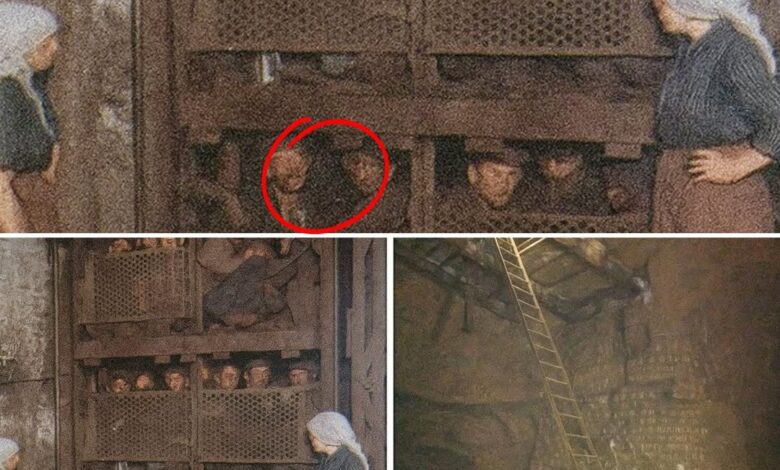TQ. “Tell my wife they knew.” — Half a century after the Black Mine massacre, a message from the grave finally exposes the secret buried beneath the coal.

In 2005, the mining town of La Mina Negra, deep in the rocky heart of Zacatecas, was still living atop the ghosts of a tragedy that defined generations. Half a century earlier, in 1955, La Minera del Sol Negro, owned by the powerful Montenegro family, suffered a disaster that changed everything.
Family games
Discover more
Princess Diana memorial items
Lionel Messi jerseys
Space exploration documentaries
Dog
Royal family biographies
Luxury travel experiences
Paul Walker tribute items
Privacy policy template
Real time updates
Pet adoption services

Twenty-three men went down into the mine that morning for their shift. None ever came back.
Discover more
Dog
K9 Hero
Science fiction novels
Romantic anniversary gifts
Puppy care products
WordPress themes
Space exploration news
Urgent news app
Space telescope viewing
UFO documentary
For fifty years, the story was simple — or so it was told: a methane explosion, a collapse, a tragic accident. The Montenegro family paid for the funerals, erected a marble memorial, and the town moved on. But everyone in Zacatecas knew there were whispers — whispers of sabotage, of screams that were heard long after the explosion, and of one radio message that no one dared to repeat aloud.
Then, in 2005, a rusted metal box changed everything.
THE DISCOVERY
It began with a landslide. After weeks of heavy rain, part of the old mine entrance caved in. A team of geology students from the University of Zacatecas, surveying the area, found a hollow tunnel that had not appeared on any maps. Inside, they found mining tools, helmets, and bones — too many to count.
And among them, an old field radio, wrapped in layers of oilcloth.
Discover more
Dog
Royal family biographies
Romantic anniversary gifts
News website theme
Alien invasion books
Science fiction novels
Spanish language courses
News aggregator service
Lionel Messi jerseys
Breaking news alerts
When they turned the dial, static hissed. Then, faintly, a voice.
Discover more
UFO documentary
WordPress themes
Astronomy equipment
Science fiction novels
Breaking news alerts
Football club merchandise
Lionel Messi jerseys
K9 Hero
Fast & Furious movie collection
Dog
Experts later confirmed it was a loop recording, a message that had been transmitting for years before the radio finally died. The words were barely audible but unmistakable:
“Dile a mi esposa… que sabían.”
Tell my wife they knew.
A NAME RETURNED TO LIFE
The voice was identified as Rafael Villaseñor, a foreman from the 1955 crew. His widow, Elena, was still alive, 84 years old, and living in a small house near the mine. When journalists told her about the discovery, she trembled, whispering, “I knew he didn’t die alone.”
Elena produced something no one expected — a letter Rafael had sent her two days before the explosion. It spoke of “strange orders from above,” of tunnels being sealed for “reasons that didn’t make sense.”
“They say we hit a vein of mercury,” he wrote. “But the engineers don’t want it reported. They said it’s better if it stays buried.”
That letter had never been made public.
THE COMPANY THAT ERASED HISTORY
In the 1950s, La Minera del Sol Negro was the pride of northern Mexico — one of the richest silver and zinc operations in the country. Its owner, Don Arturo Montenegro, was a national hero: philanthropist, politician, and mining visionary.
When the explosion occurred, Montenegro appeared on national radio, promising compensation for every family and pledging to rebuild the town. But behind closed doors, he ordered the mine sealed with concrete. He claimed it was too dangerous to reopen.
Family games
What he didn’t mention was that the explosion occurred just days before a scheduled government inspection.
Documents found in 2005 revealed that the mine’s methane detectors had been disabled the night before the accident — and that engineers had signed off on false safety reports.
THE MISSING JOURNAL
During the excavation, researchers also found a leather-bound notebook buried beneath a layer of coal dust. It belonged to Engineer Ignacio Herrera, Montenegro’s chief of operations, who vanished after the tragedy.
The journal’s pages, water-damaged but legible, described mounting tension underground:
“Something’s wrong in Tunnel 3. The air burns. The men complain of dizziness. But when I told Don Arturo, he smiled and said, ‘You saw nothing.’”
The last entry, dated two days before the explosion, read:
“If I don’t return, look in the west shaft. They buried the truth there.”
WHAT THEY FOUND IN THE WEST SHAFT
The team followed Herrera’s note. Deep in the western tunnel, they found sealed barrels—23 in total. Each one labeled with the initials S.N. (Sol Negro). Inside wasn’t silver ore. It was liquid mercury—tons of it, illegally extracted and stored.
The discovery proved what Rafael’s message had hinted: the explosion wasn’t an accident. The miners had been ordered to continue digging despite lethal mercury vapors accumulating in the tunnels. When they began collapsing, the management cut power to the ventilation system and sealed off the exits — trapping the workers inside.
For five decades, the Montenegro family’s fortune had been built on what the town called “the silver that screams.”
THE RETURN OF THE DEAD
After news of the discovery spread, the descendants of the 23 miners demanded justice. A memorial was held at the reopened entrance of La Mina Negra. For the first time, their names were read aloud with their full titles — not as “casualties,” but as “victims.”
Old miners who had survived that era confessed to hearing voices through their radios on night shifts for years afterward. “They said someone was calling for help, long after the mine was closed,” said one retired worker. “Now I know it wasn’t ghosts. It was Rafael, still trying to tell us.”
THE FAMILY’S FALL
The Montenegro dynasty, once untouchable, fell apart within months.
The company’s archives, unsealed by court order, revealed decades of environmental crimes and cover-ups. The family’s descendants, who still lived in a mansion overlooking the valley, fled the country under public outrage.
A single portrait still hangs in the municipal museum: Don Arturo Montenegro shaking hands with a group of miners — the same men who died days later.
Someone has scratched a line beneath the image. It reads:
“They knew.”
THE SCIENCE OF THE SIGNAL
Scientists later determined that the radio message survived due to a combination of low humidity, magnetic resonance from nearby minerals, and a damaged antenna that created an accidental feedback loop. The radio had been transmitting the same sentence—Rafael’s final words—for years.
But for the families, the explanation didn’t matter. What mattered was that after half a century of silence, their loved ones had spoken.
Family games
“He didn’t die quietly,” said Elena Villaseñor, holding the radio in her wrinkled hands. “He died telling the truth.”
LEGENDS AND LINGERING ECHOES
Today, the entrance to La Mina Negra remains sealed once more, this time as a historical site. Visitors leave flowers, helmets, and scraps of handwritten notes. Some swear they can still hear faint static from beneath the earth — the hum of a voice trying to finish its message.
Children play in the nearby plaza, where a mural depicts 23 silhouettes ascending into light, carrying pickaxes like torches. At the bottom, in white paint, are the words:
“Dile a mi esposa que sabían.”
Tell my wife they knew.
THE ECHO THAT WON’T DIE
Fifty years later, justice finally found its way through the cracks of rock and silence. What began as a whisper in the dark became a chorus of truth echoing through time.
And in the still nights of Zacatecas, when the wind passes through the old mining shafts, people say you can still hear Rafael’s message riding the static — a single sentence that refuses to be buried:
“Tell my wife they knew.”


